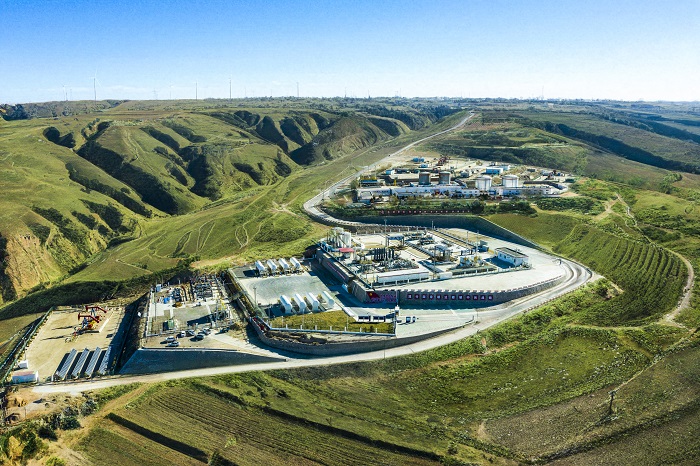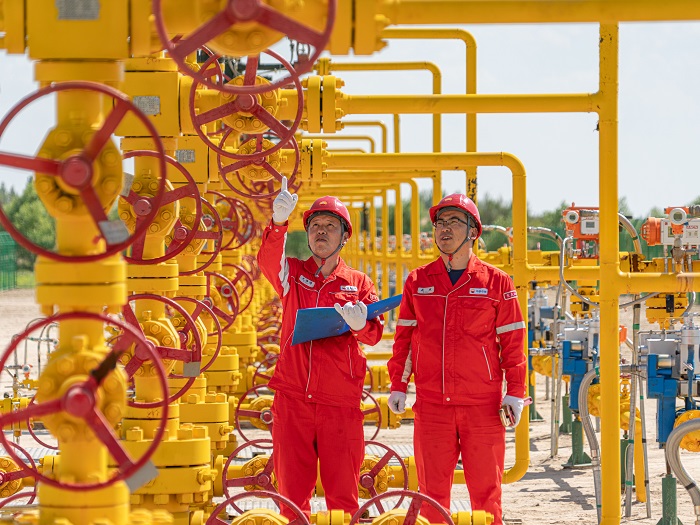The cumulative oil and gas equivalent production of China's largest oil and gas field has exceeded 1 billion tons
Recently, the cumulative production of oil and gas equivalent at China's largest oil and gas field, China National Petroleum Corporation's Changqing Oilfield, has historically exceeded 1 billion tons. This is another milestone achievement made by Changqing Oilfield following the completion of a 60 million-ton super-large oil and gas field in 2020.
The core of energy security lies in oil and gas security. One billion tons of oil and gas, if all converted into crude oil equivalent, could fill 80 West Lakes.

The Ordos Basin where the Changqing Oilfield is located is home to typical "three lows" (low permeability, low pressure and low abundance) oil and gas resources in the world. Their density is comparable to that of a "whetstone", and the difficulty of exploration and development is rarely seen in the world. Over the past 50-plus years of development and construction, several generations of Changqing oil workers have been deeply engaged in the Loess Plateau, advanced into the northern Shaanxi Plateau, fought fiercely in the Helan Mountains, and bravely ventured into the Mu Us Mountains. They have explored and formed a unique series of exploration and development technologies, transforming the "marginal oil field with no exploitation value" into the largest oil and gas field with the highest output in China at present.
Zhang Tao, the chief geologist of the Exploration Department of Changqing Oilfield, said, "Starting from low permeability, Changqing Oilfield has broken through ultra-low permeability, then fought for ultra-low permeability, liberated tight gas, and tackled shale oil. The exploration and development of oil and gas have continuously shifted to deeper layers. So far, 50 oil and gas fields have been successfully discovered, making it an important growth pole for increasing reserves and production of oil and gas energy in China."
Over the past decade, with the rapid development of China's economy, the demand for oil and gas resources has risen sharply. Changqing Oilfield has intensified its efforts in oil and gas exploration and development, promoting the large-scale development of unconventional oil and gas resources such as shale oil and tight gas, and making every effort to ensure the safe and stable supply of oil and gas. In 2013, the output exceeded 50 million tons and the western Daqing was completed as scheduled. In 2020, it surpassed 60 million tons, setting a new milestone in the history of China's petroleum industry development. In 2023, it reached 66 million tons, setting a new record for the production of oil and gas fields in China and creating a world miracle of efficient development of "three-low" oil and gas fields. According to statistics, 630 million tons of oil and gas equivalent have been produced in the past decade, which is 1.7 times the total output of the previous 44 years.

Facing the strategic deployment of building a beautiful China and the urgent demand for clean energy, Changqing Oilfield has taken accelerating the production of natural gas as an important mission. It has built the first domestic gas field with an annual output of 50 billion cubic meters, and its annual natural gas output accounts for about one quarter of the total domestic output. Twelve national natural gas trunk lines, including the West-East Gas Pipeline and the Shaanxi-Beijing Pipeline, converge in Changqing, making it the hub center of China's onshore natural gas pipeline network and an important domestic fulcrum for energy cooperation under the Belt and Road Initiative. Since it was the first to supply gas to the capital Beijing in 1997, Changqing Oilfield has cumulatively supplied over 650 billion cubic meters of natural gas to more than 50 large and medium-sized cities in the Beijing-Tianjin-Hebei region, Shaanxi-Gansu-Ningxia and other areas. It can replace 790 million tons of standard coal and reduce carbon emissions by about 1 billion tons, playing an important role in optimizing the national energy structure and improving the ecological environment.
Facing the predicament of "oil in every well but no water flow" in the basin, the Changqing Petroleum team has been exploring and researching for ten years, breaking the foreign technological monopoly and developing a series of key core technologies, successfully unlocking the oil and gas in the crevices of rocks. The three-dimensional seismic technology of the loess plateau breaks through the barrier of the extremely thick loess layer and conducts high-precision "CT" scans on the reservoirs within a kilometer underground, which can accurately discover oil and gas. In recent years, the newly added proven oil and gas reserves have accounted for one-third of the national total. The fast and efficient horizontal well drilling technology, which equips the drill bit with a "navigation", enables oil and gas Wells to be drilled quickly, accurately and well, setting multiple domestic drilling construction records. Volume fracturing technology has opened up "seepage channels" for oil and gas in dense rocks, increasing the production of a single well by more than five times. Relying on independent innovation, we have built the first domestic shale oil production base with a scale of 2 million tons for efficient development in Qingyang, Gansu Province. The annual output of shale oil in Changqing accounts for more than 60% of the total domestic output. Qi Yin, deputy manager of the shale oil capacity construction project team of Changqing Oilfield, introduced.

Meanwhile, in light of the fact that the oil and gas working area is characterized by numerous points, long lines and wide coverage, Changqing Oilfield has leveraged information technologies such as big data, cloud computing and artificial intelligence to integrate and innovate over a thousand applicable technologies. It has connected production factors such as oil and gas Wells, stations and depots, and pipelines to the Internet, promoting the gradual transformation of oil and gas production and management methods towards new industrialization The resilience and impetus for the high-quality and sustainable development of Changqing Oilfield are stronger. Since 2007, the oil and gas output of Changqing Oilfield has increased threefold, but the total number of employees has remained at around 60,000. The per capita labor productivity has ranked among the top in China's oil and gas field enterprises.
The Changqing Oilfield is located in the economically underdeveloped western regions and revolutionary old areas such as Yan 'an and Qingyang. For many years, Changqing Oilfield has been actively fulfilling the three major responsibilities of state-owned enterprises. Centering on the construction of the 10 million-ton energy base in eastern Gansu, the energy and chemical industry base in northern Shaanxi, and the natural gas processing and output base in Inner Mongolia, it has been promoting the establishment of the largest integrated oil and gas industrial cluster in China, covering storage and transportation, refining and chemical processing, sales, engineering construction, equipment manufacturing, and technology research and development. Tens of thousands of teams have gathered in the oil and gas areas to participate in oilfield construction, creating nearly one million local jobs and injecting strong impetus into ensuring national oil and gas energy security and promoting coordinated regional economic development.
